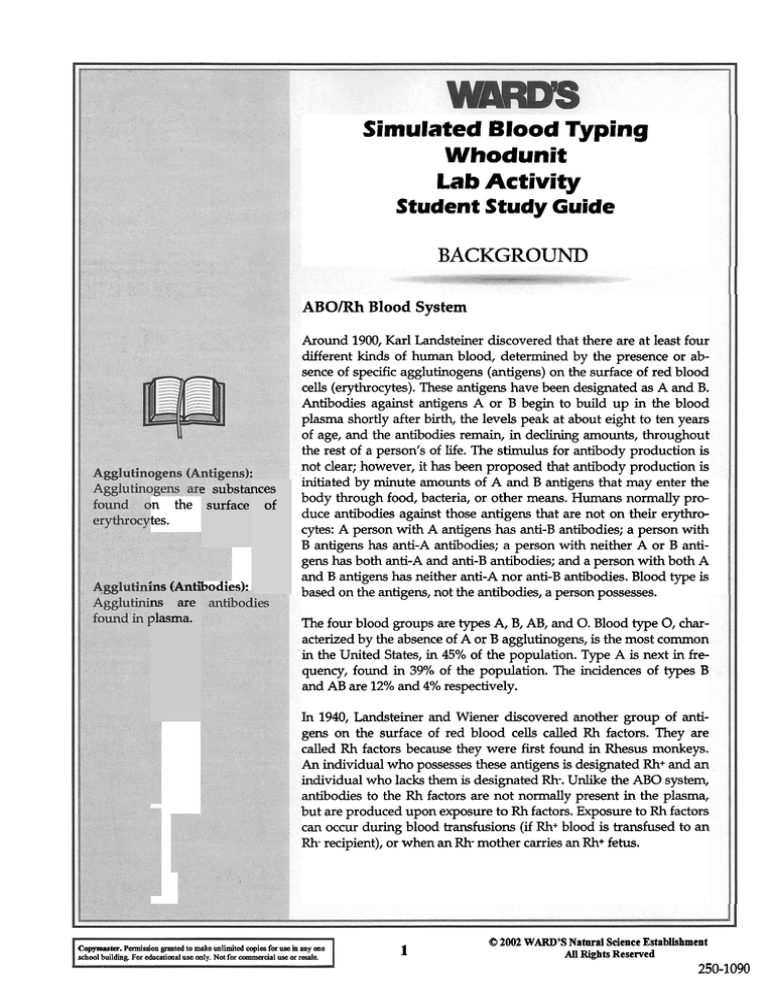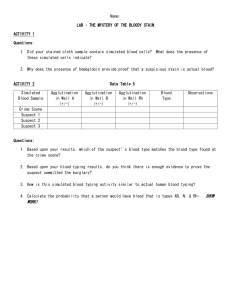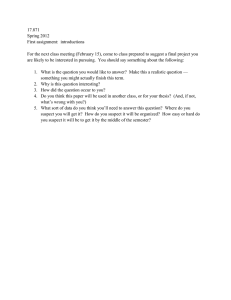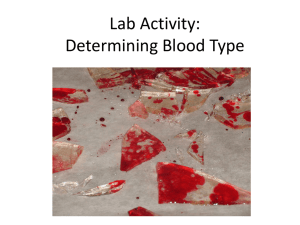
Simulated Blood Typing
Whodunit
Lab Activity
Student Study Guide
BACKGROUND
ABOIRh Blood System
substances
surface of
I
ln the
tes.
ins (Antibodies):
ns are
~lasrna.
Around 1900, Karl Landsteiner discovered that there are at least four
different kinds of human blood, determined by the presence or absence of specific agglutinogens (antigens) on the surface of red blood
cells (erythrocytes).These antigens have been designated as A and B.
Antibodies against antigens A or B begin to build up in the blood
plasma shortly after birth, the levels peak at about eight to ten years
of age, and the antibodies remain, in declining amounts, throughout
the rest of a person's of life. The stimulus for antibody production is
not clear; however, it has been proposed that antibody production is
initiated by minute amounts of A and B antigens that may enter the
body through food, bacteria, or other means. Humans normally produce antibodies against those antigens that are not on their erythrocytes: A person with A antigens has anti-B antibodies; a person with
B antigens has anti-A antibodies; a person with neither A or B antigens has both anti-A and anti-B antibodies; and a person with both A
and B antigens has neither anti-A nor anti-B antibodies. Blood type is
based on the antigens, not the antibodies, a person possesses.
The four blood groups are types A, B, AB, and 0. Blood type 0, characterized by the absence of A or B agglutinogens, is the most common
in the United States, in 45% of the population. Type A is next in frequency, found in 39% of the population. The incidences of types B
and AB are 12%and 4% respectively.
In 1940, Landsteiner and Wiener discovered another group of antigens on the surface of red blood cells called Rh factors. They are
called Rh factors because they were first found in Rhesus monkeys.
An individual who possesses these antigens is designated Rh+and an
individual who lacks them is designated Rh-. Unlike the ABO system,
antibodies to the Rh factors are not normally present in the plasma,
but are produced upon exposure to Rh factors. Exposure to Rh factors
can occur during blood transfusions (if Rh+blood is transfused to an
Rh- recipient), or when an Rh- mother carries an Rh+fetus.
Copymanta. Pamission graated to make unlimited q i s for usa in any me
school building For educsdmal use mly. Not for mmmadaluse or resale.
1
8 2002 WARD'S Natnral Science Establishment
AU Rights Reserved
250-1090
Figure 1
Antibodies
in Plasma
Can Give
Blood To
Can Receive
Blood From
Neither Anti-A nor Anti-B
0
Neither A nor B
DID YOU KXTnTA'*
I Y V V Y :
pan of a red
: 120 day
Both Anti-A and Anti-B
There is a simple test to determine blood type, performed with antisera containing high levels of anti-A, anti-B and anti-Rh agglutinins.
Several drops of each kind of antiserum are added to separate samples of blood. If agglutination (clumping) occurs only in the suspension to which the anti-A serum was added, the blood type is A. If agglutination occurs only in the anti-B mixture, the blood type is B. Agglutination in both samples indicates that the blood type is AB. The
absence of agglutination in any sample indicates that the blood type
is 0.Any sample that agglutinates in the presence of anti-Rh serum is
considered Rh+.
Agglutination Reaction of ABO Blood-Typing Sera
Reaction
Anti-A Serum
Anti-B Serum
Agglutination
No Agglutination
No Agglutination
No Agglutination
M make unlimited copiesfor use in my me
school building For edudmal use only. Not for wmmerdal use or resale.
I
No Agglutination
6 2002 WARD'S Natural Science Establishment
All Rights Reserved
Importance of Blood Typing
As noted in the table above, people can receive transfusions of only
certain blood types, depending on the type of blood they have. If incompatible blood types are mixed, erythrocyte destruction, agglutination and other problems can occur. For instance, if a person with
Type B blood is transfused with blood type A, the recipient's anti-A
antibodies will attack the incoming type A erythrocytes. The type A
erythrocytes will be agglutinated, and hemoglobin will be released
into the plasma. This problem may not be serious, unless a large
amount of blood is transfused.
-
DII1YOU K
tlnnrl
m
ed blood cells. TI?ere
sma in c
lod,
dies
present.
Blood type, an inherited characteristic, may also be used in medicolegal situations involving identification of disputed paternity. A comexclude the man as a possible parent. Blood typing does not prove
that an individual is the faker of a child; it merely indicates whether
or not he is a possible parent. For example, a child with a blood type
of AB, whose mother is type A, could not have as a father a man
whose blood type is 0.
Whenever blood has been shed in a criminal act, the identification
and typing of the blood stains are of primary importance to the crime
scene investigator. The ABO blood groups are used to screen out possible suspects involved in the crime. The first step in the investigation
is to distinguish the bloodstains from other similar looking com.
along
pounds such as fruit juices, jam, chemicals, paint, e t ~Secondly,
with a number of sophisticated tests to determine the sex of the individual from which the blood came, and the age of the blood stain, a
simple blood typing test is also performed. Although a positive
match of the suspect's blood type is not sufficient to convict someone
of a crime, it is one type of evidence that is often obtained during a
crime investigation.
I
Copymnter. Permission granted to make unlimited copies for use in any me
school buildin& For edutatioal u.nl Not for commercial w or resale.
I
8 2002 WARD'S Natural Science Establishment
AH Rights Reserved
Assume the role of a forensics lab technician
Examine suspected blood evidence found at a crime scene
Confirm that the evidence is real blood
Perform the ABO/Rh procedure to determine the blood type
Relate the evidence to four possible suspects
f1
b YOU KNOW?
3arnels a:nd their relatives are
he only mamrrlals hav
wal red 1:>load celLs.
MATERIALS
MATERIALS NEEDED PER GROUP
4
Pieces of stained cloth squares
6
Blood typing trays
18 Toothpicks
1 Microscope slide
1 Compound microscope
SHARED MATERIALS
1
1
1
1
1
1
1
1
Coppuairr. Psndssion granted to make unlimited wpies for use in my one
school building For educational use only. Not for commercial use or resale.
Vial, WARD'S Simulated Blood - Victim's blood
Vial, WARDS Simulated Blood - Suspect #1
Vial, WARD'S Simulated Blood - Suspect #2
Vial, WARD'S Simulated Blood - Suspect #3
Vial, WARD'S Simulated Blood - Suspect #4
Vial, anti-A serum
Vial, anti-B serum
Vial, anti-Rh serum
4
8 ZOO2 WARD'S Natural Science Establishment
All Rights Reserved
PROCEDURE
Although WARD'S Simulated Blood is completely safe, nonbiological, and non-toxic, you should wear the proper personal
protective equipment to mimic the experience of an actual hematology laboratory.
Scenario:
YOU KI
!e mid-l!
.
.
rculating
the bodj
1
Crime investigators were called to the scene of a burglary. Mr. Smith
had come home, only to find someone robbing his apartment. As the
criminal rushed to leave the apartment, he ran into a glass door cutting his arm and tearing his shirt. The crime investigators were able
to remove small pieces of clothing that appeared to be blood stained
from the broken glass door. p e blood samples from the crime scene,
one
the or€
along with your classmates, have been chosen to provide this last
piece of evidence and determine which of the suspects is the burglar.
Part A. Microscopic Investigation
The first step in the investigation is to distinguish the blood stains
from other similar looking compounds such as fruit juices, foods,
chemicals, paint, etc.
1. Use the provided piece of stained cloth found at the scene of the
crime. Place the stained cloth flat on a microscope slide and place
one drop of water on it.
2. View the cloth under low and high power (400X)for any clues
that would lead you to prove that the stain on the cloth is indeed
blood.
3. Describe your observations and state your conclusion in Table 1
in the Analysis section. State whether or not you believe the sample is stained with blood.
Permission granted to make unlimited copies for use in any me
school building For educaiimal use only.Not for commercialuse. or resale.
Cappus*.
5
0 2002 WARD'S Natwal Science Establishment
A1 Rights Reserved
Part B. ABOIRh Blood Typing
You will now determine the blood type of the victim, the four suspects, and the blood found at the scene of the crime.
1. Use a wax pencil to label each of your six blood typing trays as
follows:
Tray #I: Crime scene
Tray #2: Victim
Tray #3: Suspect #1
Tray #4: Suspect #2
Tray #5: Suspect #3
Tray #6: Suspect #4
2. To determine the type of blood found at the crime scene, place a
piece of the blood stained cloth, provided by your teacher, in each
of the A, B, and Rh w e b of blood typing Tray #1 labeled "Crime
sceneN.
3. Place 3-4 drops of the simulated anti-A serum on the blood
stained cloth in the A well of the tray.
Forensic' serologists study
blood, 1>load groups, and
4. Place 3-4 drops of the simulated anti-B serum on the blood
stained cloth in each B well of the tray.
5. Place 3-4 drops of the simulated anti-Rh serum on the blood
stained cloth in each Rh well of the tray.
6. Obtain three toothpicks. Stir each sample of antiserum and blood
stained cloth with a separate clean toothpick for 30 seconds. To
avoid splattering the simulated blood, do not press too hard on
the typing tray.
7. Observe the slide and record your observations in Table 2 of the
Analysis section. To confirm agglutination try reading text
through the mixed sample. If you cannot read the text, assume
you have a positive agglutinationreaction.
n
Agglutination
Copgrmster. P m s s i o n granted to make lml~nutedwples for use m any one
school blulLng For educauonal use only Not for wmmernal use or resale
6
No Agglutination
8 2002 WARD'S Natural Science Establishment
AU Rights Reserved
Once you have determined the type of moos founa at the scene of the
crime, you will then type the blood of the victim and four suspects.
8. Place 3-4 drops of the victim's blood in each of the A, B, and Rh
wells of Tray #2: Victim.
9. Place 3-4 drops of Suspect #lls blood in each of the A, B, and Rh
wells of Tray #3: Suspect #I.
10. Place 3-4 drops of Suspect #2's blood in each of the A, B, and Rh
wells of Tray #4: Suspect #2.
11. Place 3-4 drops of Suspect #3's blood in each of the A, B, and Rh
wells of Tray #5: Suspect #3.
DID YOU KNOW?
deteciion of trace blood
lrns at criime scent
12. Place 3-4 drops of Suspect #4's blood in each of the A, B, and Rh
wells of Tray #6: Suspect #4.
13. Place 3-4 drops of the simulated anti-A serum in each A well on
the five trays.
14. Place 3-4 drops of the simulated anti-B serum in each B well on
the five trays.
15. Place 3-4 drops of the simulated anti-Rh serum in each Rh well on
the five trays.
16. Stir each sample with a separate clean toothpick for 30 seconds.
To avoid splattering the simulated blood, do not press too hard
on the typing tray.
17. Observe the slide and record your observations in Table 2. To
confirm agglutination try reading text through the mixed sample.
If you cannot read the text, assume you have a positive
agglutination reaction.
WARD'S Simulated blood is non-biological and nontoxic and may beflushed down the drain.
Copgmnster. Permissiongranted to make W t e d wp~esfor use in any one
school building For educatiooal use only Not for commercialuse or resale.
7
0 2002 WARD'S Natural Science Establishment
All Rights Reserved
--
-
.
ctivity
Date:
ANALYSIS
Table 1
Observations
Conclusion
Table 2
Blood Source
Anti-A Serum
Anti-B Serum
Anti-Rh Serum
Blood Type
Crime Scene
Victim
Suspect 1
Suspect 2
Suspect 3
Suspect 4
Copym~trx.
Permision granted to make mdimited copies for use in my one
school building For educationaluse only. Not for wmmerd use or resale.
6 2002 WARD'S Natural Science Establishment
AU Rights Reserved
1. As a forensics technician, the courts have asked you to summarize your findings to the jury. Explain
what you would say in the space below (remember,it is your job to report the facts, not decide who
2. How would you respond to the accused suspect's denial of having the blood type you identified,
since he has proof that he had just received a blood transfusion with type 0 blood?
3. Why is it necessary to type the victim's blood?
4. a. Pick one of the following suspects:
Suspect #1
Suspect #2
Suspect #3
Suspect #4
Suspect #:
b. Using the information from from Figure 1and the data from your blood type analysis, what ABO
agglutinogens are present on the suspect's red blood cells?
c. What ABO agglutinins are found in the suspect's blood plasma?
d. What is the suspect's blood type?
e. If the suspect needed a blood transfusion, what blood types could he/she receive?
f. What blood types could safely receive this suspect's blood?
Copymnta. Permission granted to make unlimited copies for use in any me
school building FM educational use only. Not for c o m m d use M resale.
6 2002 WARD'S Natural Science Establishment
AU Rights Reserved
5. Create a graph or chart that depicts the percentages of each ABO blood type in the United States.
6. Using the following graphic organizer, fiU in the properties which are unique to agglutinins in the
bubbles on the right, properties common to both agglutinins and agglutinogens in the center bubbles and properties unique to agglutinogens in the bubbles on the left.
Differences
I
Copymaster. Permissimgranted to make rmlimited copis for pss in any me
schwl building For & c a t i d use only. Not for commercial ure or male
Similarities
I
Differences
8 ZOO2 WARD'S Natural Science Establishment
AU Rights Reserved
..
8.
A
z are agglutinins like security guards?
You are a defense attorney representing the accused. Your client has been shown to have the same
blood type as that found at the scene of the crime. Explain to the jury why this information alone is
not enough to convict your client.
9. As the client's attorney, you have also been provided with police videotape of the crime scene
analysis. In the video, you notice that one of the investigating officers has a bandage on his hand.
How could you use this evidence to your advantage?
10. Blood typing in one method of gathering evidence at the scene of a crime. Describe at least two
other methods that can be used in the attempted identification of a gLulty suspect.
11. Many times, a suspect may attempt to clean the area containing a blood stain at the scene of a crime.
One tool utilized by forensic investigators is a substance called luminol. Research luminol on the
internet or at the library and explain how it may be used to aid investigators at a crime scene.
Coppiaster. Permission granted to make uulimited copies for use in my one
school building For eduoatimal use only.Not forconrm~daluse or resale.
11
O 2002 WARD'S Natural Science Establishment
AU Rights Resewed



